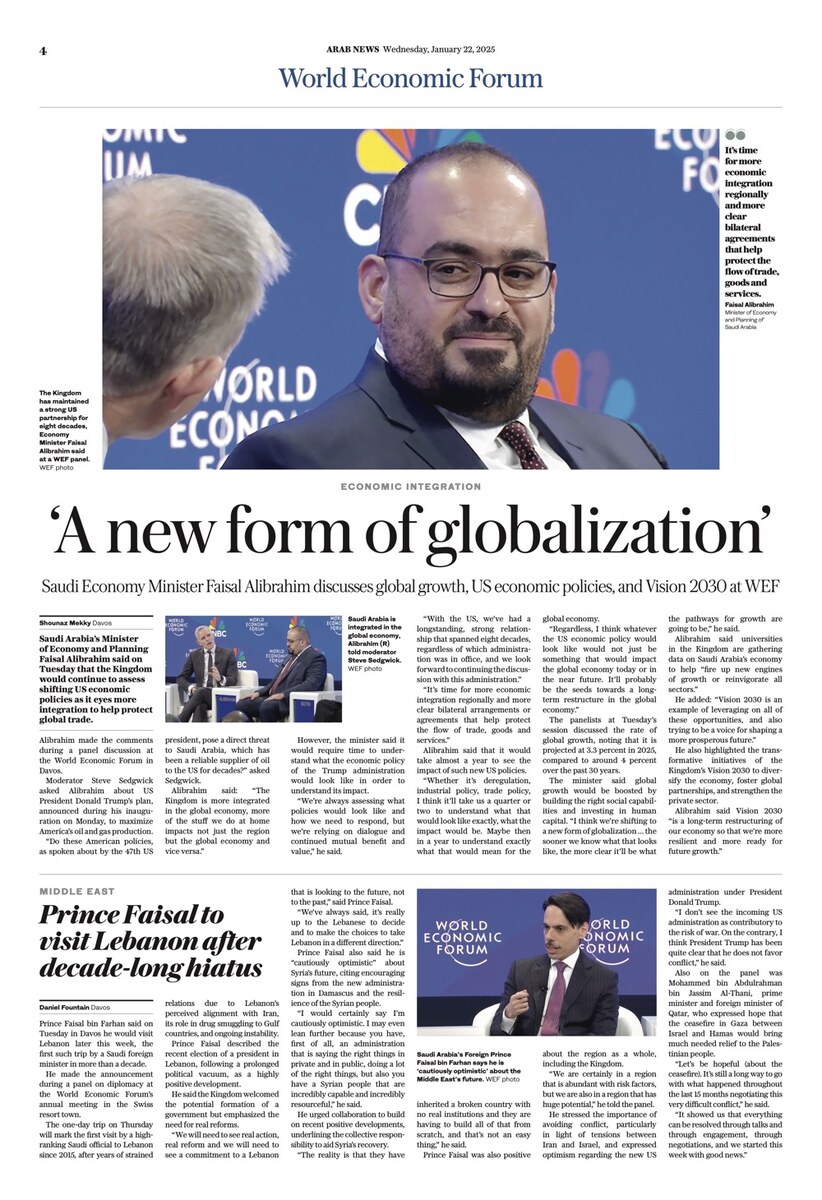DUBAI: Saudi Arabia’s Minister of Economy and Planning Faisal Alibrahim on Tuesday said the Kingdom would continue to assess shifting US economic policies as it eyes more integration to help protect global trade.
Alibrahim made the comments during a panel discussion at the World Economic Forum in Davos.
Moderator Steve Sedgwick asked Alibrahim about US President Donald Trump’s plan, announced during his inauguration on Monday, to maximize America’s oil and gas production.
“Do these American policies, as spoken about by the 47th US president, pose a direct threat to Saudi Arabia, which has been a reliable supplier of oil to the US for decades?” asked Sedgwick.
Alibrahim said: “The Kingdom is more integrated in the global economy, more of the stuff we do at home impacts not just the region but the global economy and vice versa.”
However, the minister said it would require time to understand what the economic policy of the Trump administration would look like in order to understand its impact.
“We’re always assessing what policies would look like and how we need to respond, but we’re relying on dialogue and continued mutual benefit and value,” he said.
“With the US, we’ve had a longstanding, strong relationship that spanned eight decades, regardless of which administration was in office, and we look forward to continuing the discussion with this administration.”
“It’s time for more economic integration regionally and more clear bilateral arrangements or agreements that help protect the flow of trade, goods and services.”
Alibrahim said that it would take almost a year to see the impact of such new US policies.
“Whether it’s deregulation, industrial policy, trade policy, I think it’ll take us a quarter or two to understand what that would look like exactly, what the impact would be. Maybe then in a year to understand exactly what that would mean for the global economy.”
“Regardless, I think whatever the US economic policy would look like would not just be something that would impact the global economy today (or) in the near future. It’ll probably be the seeds towards a long-term restructure in the global economy.”
The panelists at Tuesday’s session discussed the global growth rate noting that it is projected at 3.3 percent in 2025, compared to around 4 percent over the past 30 years.
The minister said global growth would be boosted by building the right social capabilities and investing in human capital.
“I think we’re shifting to a new form of globalization ... the sooner we know what that looks like, the more clear it’ll be what the pathways for growth are going to be,” he said.
Alibrahim said universities in the Kingdom are gathering data on Saudi Arabia’s economy to help “fire up new engines of growth or reinvigorate all sectors.”
He added: “Vision 2030 is an example of leveraging on all of these opportunities, (and) also trying to be a voice for shaping a more prosperous future.”
He also highlighted the transformative initiatives of the Kingdom’s Vision 2030 to diversify the economy, foster global partnerships, and strengthen the private sector.
Alibrahim said Vision 2030 “is a long-term restructuring of our economy so that we’re more resilient and more ready for future growth.”































